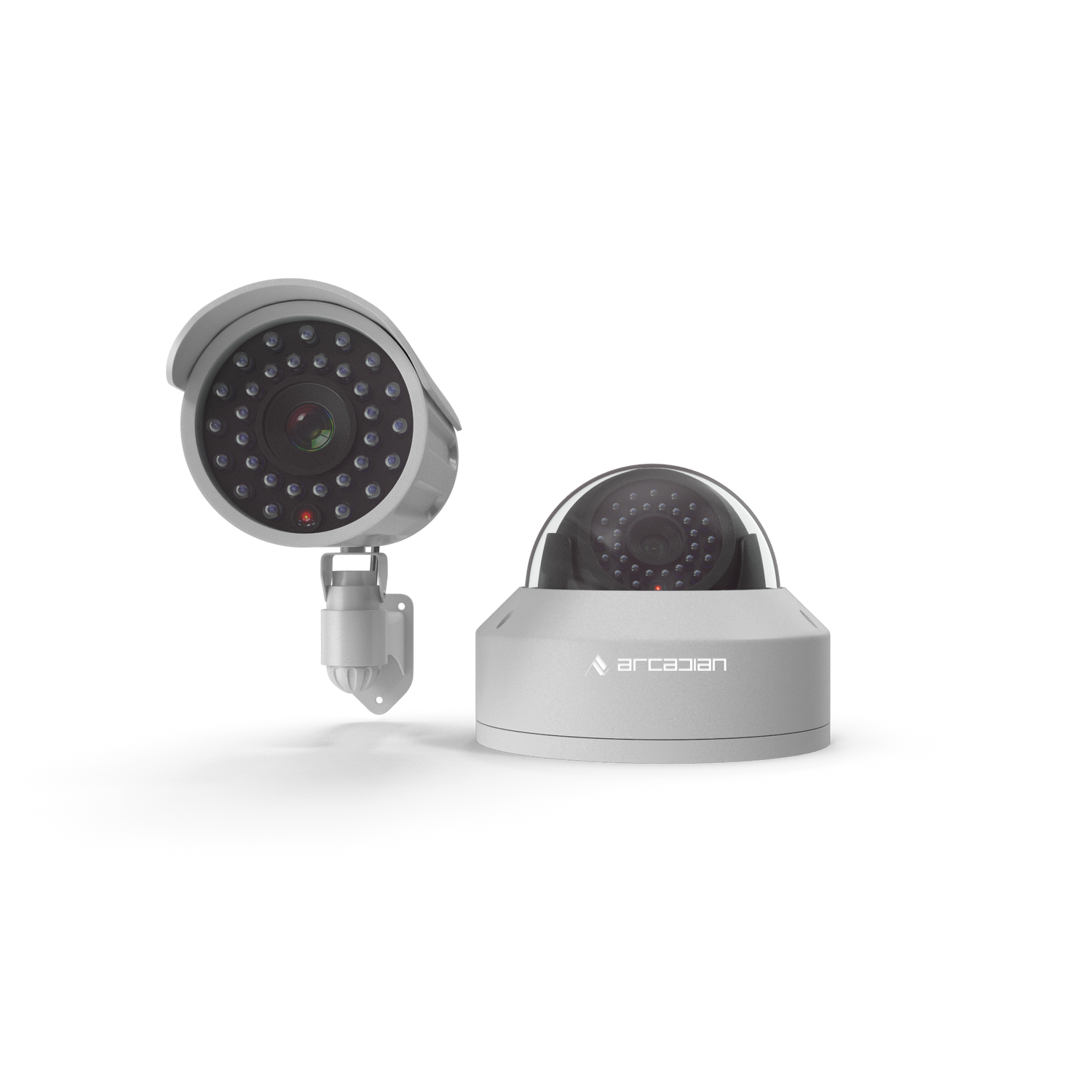The Chip War Comes to Security: How AI, Silicon, and Surveillance Are Rewriting Global Power
Chris Miller’s Chip War isn’t just about semiconductors—it’s a roadmap to the AI surveillance future. Here’s how the silicon arms race reshapes global security.

Introduction
In Chip War, Chris Miller delivers a geopolitical thriller that isn't fiction. The race for control over semiconductor manufacturing is the most important war of our time—one that determines not only economic dominance but technological sovereignty. While the book focuses on military applications and global power plays, the same chips are quietly redefining another battlefield: surveillance and physical security.
This blog post connects the dots between silicon supremacy and AI-powered video surveillance, access control, and enterprise security. It’s about why NVIDIA, TSMC, ASML, and AMD now sit at the center of business security decisions. It’s about how companies like ArcadianAI, Verkada, Genetec, Eagle Eye, and OpenAI are building the next generation of eyes and minds for every camera on the planet.
We’ll explore how AI chips fuel VSaaS (Video Surveillance as a Service), VMS (Video Management Systems), access control software, and smart surveillance analytics. We'll show how Ranger—ArcadianAI’s adaptive security assistant—takes these technologies and turns silicon into situational awareness.
In the words of Chris Miller:
“The chip industry is the most capital-intensive, geopolitically sensitive, and innovation-driven business in human history.”
And it now drives your security too.
Quick Summary / Key Takeaways
-
AI surveillance is now inseparable from global chip manufacturing.
-
VSaaS and VMS platforms rely on specialized silicon for real-time analytics.
-
Brands like NVIDIA, Qualcomm, Intel, and AMD are security players.
-
ArcadianAI’s Ranger adapts across chipsets, outperforming fixed, legacy systems.
-
The future of surveillance is AI-native, cloud-first, and chip-conscious.
Background & Relevance
Why does chip warfare matter to your security camera?
Because today’s cameras don’t just record—they interpret. And interpretation requires AI. AI requires silicon. And that silicon is forged in one of the most complex geopolitical supply chains ever devised.
Here’s why this matters:
-
Over 90% of advanced chips are produced by TSMC in Taiwan, which sits at the epicenter of U.S.-China tensions.
-
Video analytics—such as facial recognition, behavior analysis, or motion detection—rely heavily on GPUs, NPUs, and TPUs.
-
Every VSaaS vendor is now, effectively, a chip company—whether they realize it or not.
In Chip War, Miller outlines how the U.S. blocked China’s access to EUV lithography machines from ASML to curb its AI development. Why? Because whoever builds the best chips, trains the best models.
Security platforms are now part of that arms race.
Relevant Stats:
-
The AI video surveillance market is projected to hit $63 billion by 2030 (Allied Market Research).
-
AI chip spending in physical security is growing at 25% CAGR (MarketsandMarkets).
-
Over 80% of VMS and VSaaS vendors now use GPU acceleration in their analytics pipelines.
Core Topic Exploration
The Chip Foundation of Surveillance
At the heart of every AI detection event—whether it’s an object spotted, a face recognized, or a perimeter breached—is silicon.
-
NVIDIA dominates GPU-accelerated AI video analytics. Its Jetson line is used in edge AI devices, while data center GPUs like the A100 and H100 process VMS analytics at scale.
-
Google uses TPUs (Tensor Processing Units) in its cloud surveillance and edge AI platforms.
-
Qualcomm Snapdragon platforms power many smart cameras with integrated AI.
-
Intel’s OpenVINO toolkit allows VMS providers to optimize inference on Intel CPUs and VPUs.
“No one wins a war without controlling the supply of advanced computing,” writes Miller. That includes crime prevention, not just kinetic conflict.
VMS and VSaaS—Powered by AI Chips
Major VSaaS/VMS Brands Using AI Acceleration:
| Vendor | AI Chip Used | AI Features |
|---|---|---|
| Verkada | NVIDIA Jetson/Orin | Facial detection, license plate reading |
| Genetec | Intel, NVIDIA | Traffic analytics, real-time alerts |
| Eagle Eye | Google Cloud TPUs | Cloud video indexing, object detection |
| Rhombus | Qualcomm AI Engine | Behavioral tracking, environmental sensors |
| ArcadianAI | Chip-agnostic | Adaptive AI analysis, weather-aware alerts |
Unlike static platforms, ArcadianAI is hardware-agnostic. Ranger, our AI assistant, adapts to available compute—whether it’s an edge NVR with a Jetson Xavier or a hybrid cloud setup using Google TPUs.
Ranger – The AI That Understands Silicon
Ranger doesn’t just process video—it understands the environment, the silicon, and the intent.
-
Dynamic load balancing: Ranger detects available GPU/CPU/TPU resources and adapts inference.
-
Latency-aware response: Prioritizes critical alerts based on chip performance and bandwidth.
-
Chip-based failover: When cloud inference fails, Ranger falls back to edge processing.
With traditional VSaaS, AI either works—or it doesn’t. With ArcadianAI, it evolves.
Comparisons & Use Cases
AI Surveillance Platform Comparison Table
| Feature | ArcadianAI | Verkada | Genetec | Eagle Eye | Rhombus |
|---|---|---|---|---|---|
| Camera Agnostic | ✅ | ❌ (proprietary) | ✅ | ✅ | ❌ |
| Chip Flexibility | ✅ | ⚠️ Limited | ✅ | ⚠️ Cloud-only | ⚠️ Mobile chip |
| Edge + Cloud Hybrid | ✅ | ⚠️ Partial | ✅ | ✅ | ❌ |
| Real-time Adaptive AI | ✅ | ❌ | ⚠️ Delayed | ⚠️ Basic | ❌ |
| End-to-End Encryption | ✅ | ✅ | ✅ | ✅ | ✅ |
| Ranger AI Assistant | ✅ | ❌ | ❌ | ❌ | ❌ |
Use Case 1: Retail Chain Under Chip Constraint
A U.S. retailer using Intel iGPU-based NVRs couldn’t process advanced video analytics under Genetec. ArcadianAI’s Ranger optimized AI inference using Intel’s OpenVINO toolkit—no hardware upgrade needed.
Use Case 2: Harsh Climate Oil Field
Verkada’s fixed hardware failed during GPU throttling in extreme temperatures. ArcadianAI deployed on weather-rated Axis cameras with NVIDIA Jetson Xavier chips—fully operational even under 115°F.
Use Case 3: Multi-National Franchise Using Mixed Brands
With Hikvision, Uniview, and Axis cameras across 3 continents, most VSaaS platforms failed to deliver unified analytics. ArcadianAI integrated all streams, auto-detected chipsets, and balanced inference loads dynamically.
Common Questions (FAQ)
What does Chip War have to do with physical security?
Everything. The chips used to train AI models and run surveillance analytics are subject to geopolitical tensions, export bans, and supply chain fragility.
Can security systems run without AI chips?
Yes—but not effectively. Basic recording can function, but real-time threat detection, behavior analytics, and forensic search require AI acceleration.
Which chip vendors are most important in video surveillance?
NVIDIA (GPU), Intel (CPU/VPU), Qualcomm (mobile AI), and Google (TPU) dominate. Others like AMD and Tenstorrent are emerging.
How does ArcadianAI handle hardware limitations?
Ranger is chip-agnostic and software-adaptive. It can run models on edge devices, hybrid servers, or in the cloud based on available compute.
Why can’t I just use my existing VMS?
Legacy VMS systems aren’t built for adaptive AI. They’re fixed-function, and often require proprietary hardware to scale. ArcadianAI runs across brands, environments, and chip architectures.
Conclusion & CTA
The silicon wars aren’t just happening in Taiwan and Washington—they’re unfolding in your server rooms, your retail stores, and your distribution centers.
The future of surveillance belongs to those who master the intersection of silicon and software. Brands like ArcadianAI are winning because they build for adaptability—across chips, clouds, and cameras.
In the new world defined by Chip War, AI isn’t optional. It’s foundational. And ArcadianAI is here to make sure your cameras aren’t stuck in 2012 while your adversaries operate in 2030.
Get the AI that adapts to your silicon.
👉 Request a demo of ArcadianAI today
Internal Links
External Links

Security is like insurance—until you need it, you don’t think about it.
But when something goes wrong? Break-ins, theft, liability claims—suddenly, it’s all you think about.
ArcadianAI upgrades your security to the AI era—no new hardware, no sky-high costs, just smart protection that works.
→ Stop security incidents before they happen
→ Cut security costs without cutting corners
→ Run your business without the worry
Because the best security isn’t reactive—it’s proactive.







